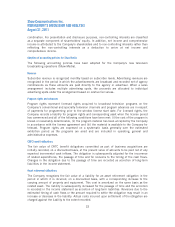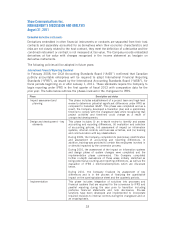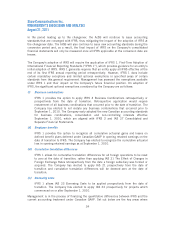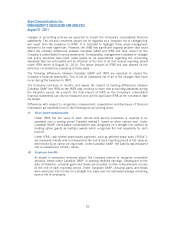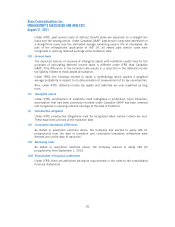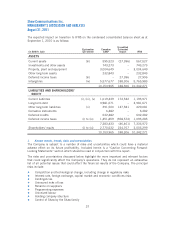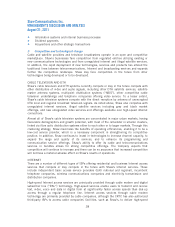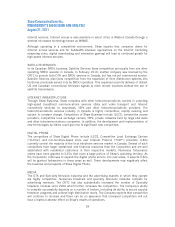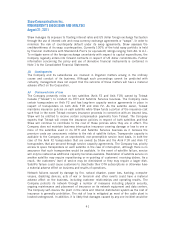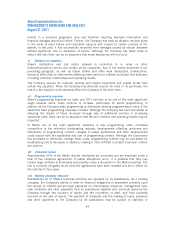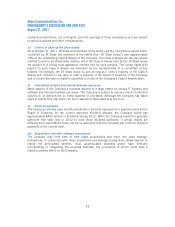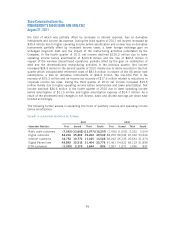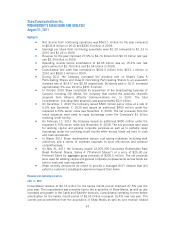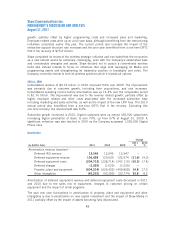Shaw 2011 Annual Report Download - page 42
Download and view the complete annual report
Please find page 42 of the 2011 Shaw annual report below. You can navigate through the pages in the report by either clicking on the pages listed below, or by using the keyword search tool below to find specific information within the annual report.Shaw Communications Inc.
MANAGEMENT’S DISCUSSION AND ANALYSIS
August 31, 2011
ŠInformation systems and internal business processes
ŠDividend payments
ŠAcquisitions and other strategic transactions
i) Competition and technological change
Cable and satellite providers and television broadcasters operate in an open and competitive
marketplace. Shaw’s businesses face competition from regulated entities utilizing existing or
new communications technologies and from unregulated internet and illegal satellite services.
In addition, the rapid deployment of new technologies, services and products has altered the
traditional lines between telecommunications, Internet and broadcasting services and expands
further the competitive landscape. Shaw may face competition in the future from other
technologies being developed or to be developed.
CABLE TELEVISION AND DTH
Shaw’s cable television and DTH systems currently compete or may in the future compete with
other distributors of video and audio signals, including other DTH satellite services, satellite
master antenna systems, multipoint distribution systems (“MDS”), other competitive cable
television undertakings and telephone companies offering video service. To a lesser extent,
Shaw’s cable television systems compete with the direct reception by antenna of unencrypted
OTA local and regional broadcast television signals. As noted above, Shaw also competes with
unregulated internet services, illegal satellite services including grey and black market
offerings, and new unregulated video services and offerings available over high-speed internet
connections.
Almost all of Shaw’s cable television systems are concentrated in major urban markets, having
favourable demographics and growth potential, with most of the remainder in smaller clusters,
linked via fibre optic distribution systems either to each other or to larger markets. Through this
clustering strategy, Shaw maximizes the benefits of operating efficiencies, enabling it to be a
low-cost service provider, which is a necessary component in strengthening its competitive
position. In addition, Shaw continues to invest in technologies to increase channel capacity, to
expand the range and quality of its services, and to enhance its programming and
communication service offerings. Shaw’s ability to offer its cable and telecommunications
services in bundles allows for strong competitive offerings. The Company expects that
competition will continue to increase and there can be no assurance that increased competition
will not have a material adverse effect on Shaw’s results of operations.
INTERNET
There are a number of different types of ISPs offering residential and business Internet access
services that compete or may compete in the future with Shaw’s Internet services. These
include independent basic access service providers (both national and regional), incumbent
telephone companies, wireless communications companies and electricity transmission and
distribution companies.
High-speed Internet access services are principally provided through cable modem and digital
subscriber line (“DSL”) technology. High-speed services enable users to transmit and receive
text, video, voice and data in digital form at significantly faster access speeds than dial-up
access through a regular telephone line. Internet access services through cable modem
technology are primarily provided by cable companies, although the CRTC has also authorized
third-party ISPs to access cable companies’ facilities, such as Shaw’s, to deliver high-speed
38






